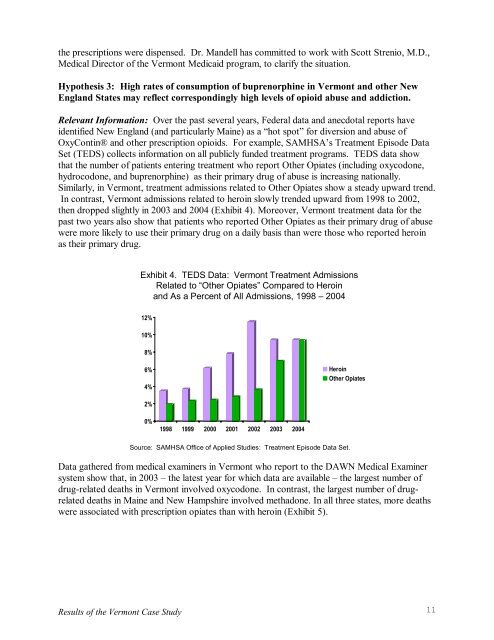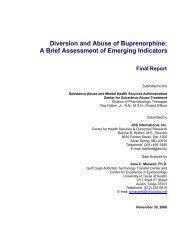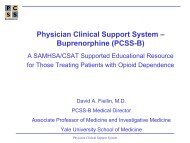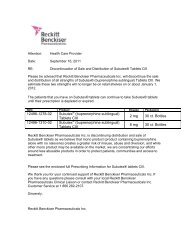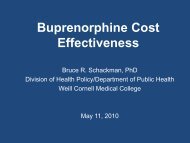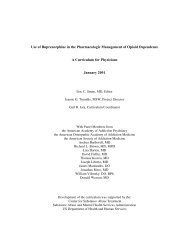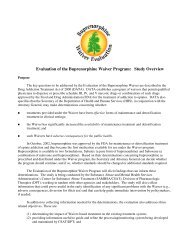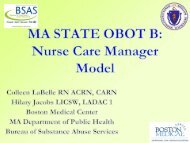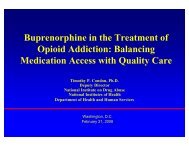Diversion and Abuse of Buprenorphine: A Brief Assessment of ...
Diversion and Abuse of Buprenorphine: A Brief Assessment of ...
Diversion and Abuse of Buprenorphine: A Brief Assessment of ...
You also want an ePaper? Increase the reach of your titles
YUMPU automatically turns print PDFs into web optimized ePapers that Google loves.
the prescriptions were dispensed. Dr. M<strong>and</strong>ell has committed to work with Scott Strenio, M.D.,<br />
Medical Director <strong>of</strong> the Vermont Medicaid program, to clarify the situation.<br />
Hypothesis 3: High rates <strong>of</strong> consumption <strong>of</strong> buprenorphine in Vermont <strong>and</strong> other New<br />
Engl<strong>and</strong> States may reflect correspondingly high levels <strong>of</strong> opioid abuse <strong>and</strong> addiction.<br />
Relevant Information: Over the past several years, Federal data <strong>and</strong> anecdotal reports have<br />
identified New Engl<strong>and</strong> (<strong>and</strong> particularly Maine) as a “hot spot” for diversion <strong>and</strong> abuse <strong>of</strong><br />
OxyContin® <strong>and</strong> other prescription opioids. For example, SAMHSA’s Treatment Episode Data<br />
Set (TEDS) collects information on all publicly funded treatment programs. TEDS data show<br />
that the number <strong>of</strong> patients entering treatment who report Other Opiates (including oxycodone,<br />
hydrocodone, <strong>and</strong> buprenorphine) as their primary drug <strong>of</strong> abuse is increasing nationally.<br />
Similarly, in Vermont, treatment admissions related to Other Opiates show a steady upward trend.<br />
In contrast, Vermont admissions related to heroin slowly trended upward from 1998 to 2002,<br />
then dropped slightly in 2003 <strong>and</strong> 2004 (Exhibit 4). Moreover, Vermont treatment data for the<br />
past two years also show that patients who reported Other Opiates as their primary drug <strong>of</strong> abuse<br />
were more likely to use their primary drug on a daily basis than were those who reported heroin<br />
as their primary drug.<br />
Exhibit 4. TEDS Data: Vermont Treatment Admissions<br />
Related to “Other Opiates” Compared to Heroin<br />
<strong>and</strong> As a Percent <strong>of</strong> All Admissions, 1998 – 2004<br />
12%<br />
10%<br />
8%<br />
6%<br />
4%<br />
2%<br />
0%<br />
1998 1999 2000 2001 2002 2003 2004<br />
Heroin<br />
Other Opiates<br />
Source: SAMHSA Office <strong>of</strong> Applied Studies: Treatment Episode Data Set.<br />
Data gathered from medical examiners in Vermont who report to the DAWN Medical Examiner<br />
system show that, in 2003 – the latest year for which data are available – the largest number <strong>of</strong><br />
drugrelated deaths in Vermont involved oxycodone. In contrast, the largest number <strong>of</strong> drugrelated<br />
deaths in Maine <strong>and</strong> New Hampshire involved methadone. In all three states, more deaths<br />
were associated with prescription opiates than with heroin (Exhibit 5).<br />
Results <strong>of</strong> the Vermont Case Study<br />
11


